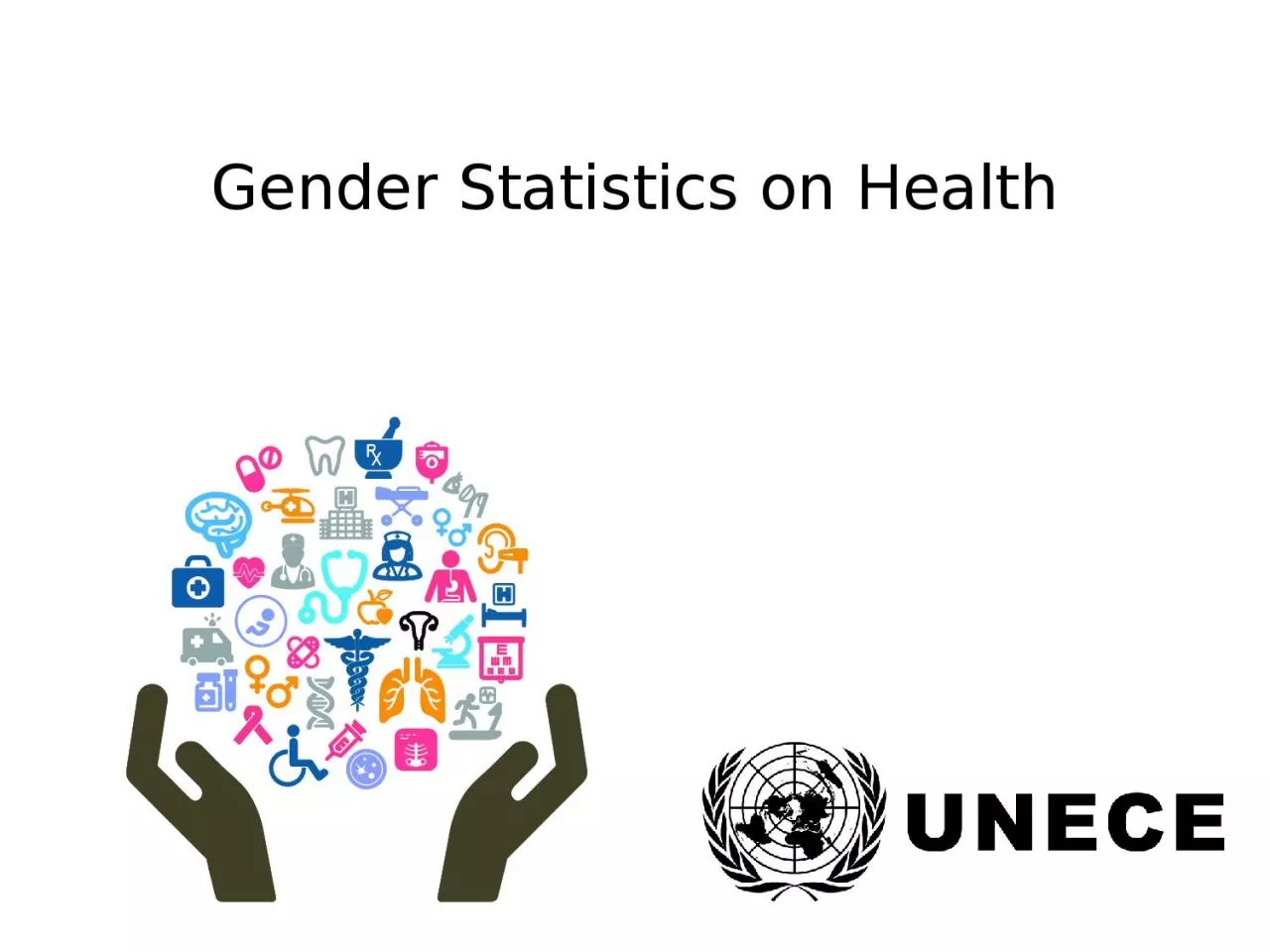

Session outline Health and statistics Gender and health Data sources Understanding key gender indicators Practical exercise Some determinants of health Sex biology Women need access to health care during pregnancy ID: 931635
Download Presentation The PPT/PDF document "Gender Statistics on Health" is the property of its rightful owner. Permission is granted to download and print the materials on this web site for personal, non-commercial use only, and to display it on your personal computer provided you do not modify the materials and that you retain all copyright notices contained in the materials. By downloading content from our website, you accept the terms of this agreement.
Slide1
Gender Statistics on Health
Slide2Session outline
Health and statisticsGender and healthData sources
Understanding key gender indicators
Practical exercise
Slide3Some determinants of health:
Sex (biology)Women need access to health care during pregnancyGender
Men are more likely to smoke and consume alcohol
Poverty
The infant mortality rate is higher in the lowest income
groupsHealth equity Reducing avoidable health differences by taking into consideration specific needs according to sex, gender, age, minority groups, etc.
“A state of complete physical, mental and social well‐being and not merely the absence of disease or infirmity” (WHO, 1946)
Slide4The importance of
health statistics
One of the widest statistical
domains
Incorporates
a great variety of data e.g. on incidence and
prevalence of diseasesUsed to evaluate health care system performance by examining levels of health in a populationUsed to analyze different determinants of health status Used by Governments to inform and monitor health policy
Slide5Gender and health
Gender norms
Women
Lack of time (prioritize
others’ needs
)Worse socioeconomic conditions
Gendered health outcomesWomenBarriers to use of healthcare servicesHealth equity for men and women:Same possibilities for men and women to access healthcare services (gender equality)In healthcare services men and women should be treated in proportion to their need (gender equity)Gender statistics on health: Monitor the differences between men and women in health statusProvide evidence for policies
Men
Higher-risk
behaviours
Men
Higher risk of disease and premature death
Greater number of accidents and violence-related injuries
Slide6Example: adolescent fertility rate
M
easures
the annual number of births to women
aged 15
to 19 per
1,000 women in that age groupProvides a measure of reproductive health focusing on a vulnerable groupEarly pregnancies are subject to higher risk of complications and higher risk to child healthPossible strategiesEducation including sex educationEmployment opportunities for youthFamily planning services and knowledgeData: The World Bank
Slide7Data sources
Administrative recordsHospital records, healthcare services, other health providersBirth registersInformation on morbidity and mortality
Reports on vaccinations
Maternal health and congenital malformation data
Civil registers and vital
registrationBirth and death data Causes of death
Slide8Data sources
SurveysHousehold surveysSpecific diseasesHealth issues that are often unreported or undetected
Gender-based violence
Sexual and reproductive health
Attitudes and behaviours
Nutrition and dietBirth historiesDetailed questions on women’s pregnancies and reproductive outcomes
Slide9Data sourcesPopulation and housing censuses
Basic information on fertility and mortalityPrevalence of disabilitiesQuestions are limited
Infrequent
Not suited for collecting
detailed and sensitive
information about health
Slide10Health system statistics
Kyrgyzstan
1995
Most
recent year available
Total expenditure on health per capita
(PPP international $)59.4215*Total expenditure on health (per cent of GDP)6.006.50*
Density of physicians
(per
1,000
population)
3.208
1.854
*
Number of hospitals
341
184
**
Number
of beds
(per
10,000
population)
86
45
**
* 2014, ** 2016
Sources
: World
Health Organization, National Statistical Committee of the Kyrgyz Republic, World Bank
Slide11Some key gender indicators
Life expectancy at birth Healthy life expectancy (Average number of years in ‘full health
’)
Causes of death (COD)
(Age-standardized death rates, per 100,000 population
)Obesity(Percentage of adult population with a BMI≥30)Adolescent fertility rate
(Number of births to women aged 15-19, per 1,000 women) Female 75 Male 67 Female 67 Male 61Source: World Health Organization, Global Health Observatory country views
Slide12Some key gender indicators
Infant mortality rate(Probability of a newborn dying during the first year of life, per 1,000 live births)
Neonatal deaths
(Number
of deaths occurring in the first 28 days of life, per 1,000 live births
)Incidence of low birth weight(Percentage of live-born infants that weigh less than
2,500g)Immunization coverage for 1-year-olds(Percentage of one year-olds who have received 3 doses of a specific vaccine in a given year)Maternal mortality(Number of maternal deaths, per 100,000 live births) 12 19 76Source: Unicef, Global Health Observatory country views
Slide13Example: life
expectancy at birthData: World
Health
Organization
,
The World Bank Life expectancy at birth for both sexes increased over this period
Gender gap persists
Slide14Example : causes of death
Data
: World
Health
Organization
, Disease and injury country estimates
Slide15Example: risk factors for non-communicable diseases
Male
Female
Kyrgyzstan
Region
AverageKyrgyzstanRegion AverageCurrent tobacco smoking(age-standardized) 201550.5%33.7%*3.7%3.5%*
Total
alcohol
consumption per capita
(
litres of pure alcohol) 2010
6.7
9.3
2.0
2
.5
Raised
blood pressure
(age-standardized) 2015
27.4%
27.5%
25.7%
24.5%
Obesity
(age-standardized)
2016
14.0%
15.0%
18.6%
19.8%
Data
: World
Health
Organization
,
Non-Communicable
diseases, Risk
factors
Slide16Practical exercise: maternal mortality ratio
Get into groups of about 5 peopleStart by calculating the missing numbers in the tableThen discuss the questions and write some ideas on your flipchart (about 20 minutes:
3-4 ideas per
question)
Be ready to report back the most interesting observations to the rest of the workshop
For the discussion items: not looking for ‘the right answers’: there are many, many right answers here!